3 CHEMICAL SIGNS AND SYMBOLS
3.1 Chemical Arrows. The braille representation of arrows listed below must be used in place of the ones listed in the Nemeth Code. All other arrows must be transcribed as required by the Nemeth Code.
Up-pointing
Regular |
 |
$< |
| Boldface |
 |
$_< |
Down-pointing
Regular |
 |
$% |
| Boldface |
 |
$_% |
Bold up-pointing followed
by regular down-pointing |
 |
$_<"% |
Regular up-pointing followed
by bold down-pointing |
 |
$<"_% |
Regular up-pointing followed
by regular down-pointing |
 |
$<"% |
Vertical or oblique dipole
Up-pointing |
 |
$+< |
| Down-pointing |
 |
$+% |
Half-barb up-pointing followed
by half barb down-pointing |
 |
$@<",% |
Horizontal
Dipole, right-pointing |
 |
$+3o |
| Dipole, left-pointing |
 |
$[3# |
| Crossed arrow |
 |
/$[3o |
3.2 Bonds
| Single regular |
. |
* |
| Single bold or hollow |
 |
/ |
| Small x |
x |
x |
| Pair, regular |
: ¨ |
? |
| Pair, hollow or bold |
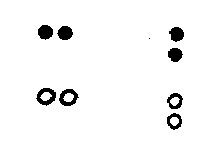 |
# |
| Pair, x's |
 |
[ |
Pair, right or upper bold or hollow,
left or lower regular |
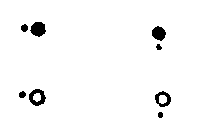 |
] |
Pair, right or upper x, left or
lower regular |
 |
% |
Pair, right or upper regular, left or
lower bold or hollow |
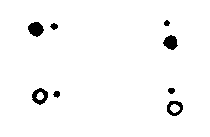 |
& |
Pair, right or upper regular,
left or lower x |
 |
$ |
Pair, right or upper bold or hollow,
left or lower x |
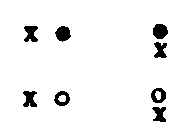 |
: |
Pair, right or upper x, left or
lower bold or hollow |
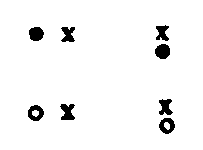 |
> |
Triplet (three pairs of regular
electron dots) |
=
or  |
\ |
Other triplets
Insert dots 46 before a pair shown horizontally
in the list above to indicate that the arrangement
is a triplet. For example: |
 |
.% |
3.2.2 Horizontal (including indicators)
| Single |
 |
_3] |
| Double |
 |
_7] |
| Triple |
 |
_=] |
| Arrow, right-pointing |
 |
_3o] |
| Arrow, left-pointing |
 |
_[3] |
| Barred |
 |
_\] |
| Bold |
 |
_g] |
| Broken |
 |
_2] |
| Dotted |
 |
_1] |
| Jagged, single |
 |
_e] |
| Jagged, double |
 |
_ei] |
| Wavy, single |
 |
_9] |
| Wavy, double |
 |
_95] |
3.2.3 Oblique
| Lower left to upper right |
 |
_/ |
| Lower left to upper right, double |
 |
_// |
| Upper left to lower right |
 |
_* |
| Upper left to lower right, double |
 |
_** |
| Arrow, lower left to upper right |
 |
_/< |
| Arrow, lower right to upper left |
 |
_*< |
| Arrow,, upper left to lower right |
 |
_*% |
| Arrow, upper right to lower left |
 |
_/% |
| Broken, lower left to upper right |
 |
_2/ |
| Broken, upper left to lower right |
 |
_2* |
| Dotted, lower left to upper right |
 |
_1/ |
| Dotted, upper left to lower right |
 |
_1* |
| Barred, lower left to upper right |
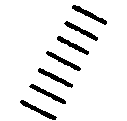 |
_x/ |
| Barred, upper left to lower right |
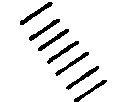 |
_x* |
Bonds, cont.
3.2.4 Vertical
| Single |
| |
_ |
| Double |
|| |
__ |
| Triple |
||| |
___ |
| Arrow, up-pointing |
 |
_< |
| Arrow, down-pointing |
 |
_% |
| Barred |
 |
_x |
| Bold |
 |
_g |
| Broken |
 |
_2 |
| Dotted |
 |
_1 |
| Jagged, single |
 |
_e |
| Jagged, double |
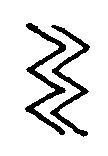 |
_ei |
| Wavy, single |
 |
_9 |
| Wavy, double |
 |
_95 |
3.2.5 Wedges, Vertical or Oblique
| Down-pointing, normal outline |
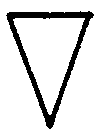 |
_m |
| Up-pointing, normal outline |
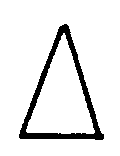 |
_u |
| Down-pointing, filled in |
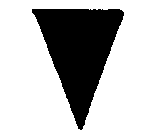 |
_p |
| Up-pointing, filled in |
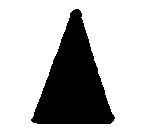 |
_v |
| Down-pointing, dotted outline |
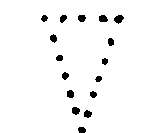 |
_1m |
| Up-pointing, dotted outline |
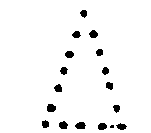 |
_1u |
| Down-pointing, dashed outline |
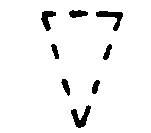 |
_2m |
| Up-pointing, dashed outline |
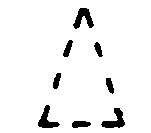 |
_2u |
| Down-pointing, barred |
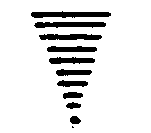 |
_xm |
| Up-pointing, barred |
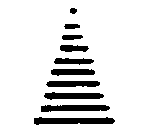 |
_xu |
3.2.6 Wedges, Horizontal (including indicators)
| Right-pointing, normal outline |
 |
_o] |
| Left-pointing, normal outline |
 |
_[] |
| Right-pointing, filled in |
 |
_r] |
| Left-pointing, filled in |
 |
_w] |
| Right-pointing, dotted outline |
 |
_1o] |
| Left-pointing, dotted outline |
 |
_1[] |
| Right-pointing, dashed outline |
 |
_2o] |
| Left-pointing, dashed outline |
 |
_2[] |
| Right-pointing, barred |
 |
_|o] |
| Left-pointing, barred |
 |
_|[] |
3.3 Ring Structures
Vertices (this two-celled symbol represents
any unlabeled vertex)
 [o
[o
Circle (broken outline)
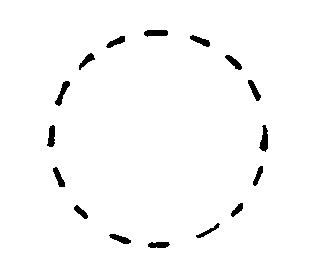 $bc $bc
Hexagon (broken outline)
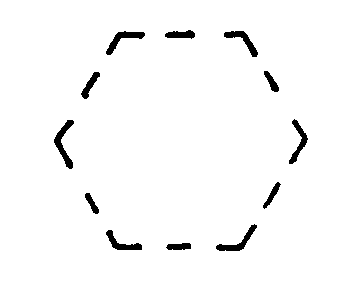 $b6
$b6
3.4 Miscellaneous Symbols and Indicators
3.4.1 Chemical Period
3.4.2 Modifiers. These symbols are to be used as spatial modifiers only. In linear expressions, the full construct of the Nemeth Code must be used. (See Examples 5.3.1-9 and 7.2-3.)
| Crossed O |
 |
@.o |
| Plus sign within a circle |
 |
$c+ |
| Minus sign within a circle |
 |
$c- |
3.4.3 Lines (partitions, not bonds)
3.4.4 Modified-Letter Indicators
Small capital* @",
Barred capital @;|,
Example 3.4.4-1: (small capital D) D
@",d
Example 3.4.4-2: (barred capital R) 
@;|,r
*Assuming the small capital letter is on the same level as normal letters.
3.5 Symbols for the Chemical Elements. The Nemeth Code defines "sign" as the printed mark and "symbol" as the braille representation of that sign. The usual nomenclature for the letter(s) representing the name of a chemical element is "chemical symbol." In this Chemistry Code, the word "SYMBOL" (all upper case) is used to denote the letter(s) representing a chemical element and "symbol" (lower case) to denote the meaning as given in the Nemeth Code. A SYMBOL for a chemical element consists of a single capitalized letter or a capitalized letter followed by one or more lower case letters. These SYMBOLS are not abbreviations as defined by the Nemeth Code, (i.e., Nemeth Code Rule VIII does not apply to SYMBOLS).
** CAUTION ** In print, sanserif type form is often employed in tables and diagrams. In this case, the capital I (eye) and the lower case l (ell) are easily confused. Upon careful examination it is usually possible to distinguish between them as the I is usually thicker than the l. Be aware of this and be sure to discriminate.
3.5.1 Capitalization. When SYMBOLS appear in a series, as in a molecule, each SYMBOL must be capitalized individually.
3.5.2 Spacing. Follow the print spacing.
Example 3.5.2-1: CH
,c,h
Example 3.5.2-2: MgO
,mg,o
Example 3.5.2-3: H--O--H
,h_3],o_3],h
3.5.3 Punctuation. Chemical SYMBOLS must be punctuated in the mathematical mode as defined in Nemeth Code Rule VI.
Example 3.5.3-1: Water is HOH.
,wat] is ,h,o,h_4
|
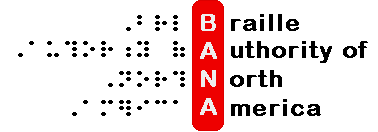 Braille Authority of North American (BANA)
Braille Authority of North American (BANA)















 [o
[o $bc
$bc $b6
$b6